Do You Want to Add a Sunroom? Here’s Everything You Need to Know
A glass- or screen-enclosed space connects you with the outdoors. Here’s how to decide which seasonal room features suit your house best.
Sunrooms, filled with sunlight and cozy patio furniture, are the ideal spot to unwind with a beverage and a good book. When you add a sunroom, these transitional spaces connect your home with the outdoors while protecting you from the elements, allowing you to enjoy the best of indoor and outdoor living at the same time. If you’re considering adding a sunroom to your home, you should know all your options. There’s a lot to consider between the different types of seasonal rooms, materials choices, and budget concerns. Use this guide for everything you need to know before you add a sunroom.
Related: What's a Solarium, and How's It Different from a Sunroom?
Types of Sunrooms
Seasonal rooms come in many forms. Here are the basic types to consider if you want to add a sunroom.
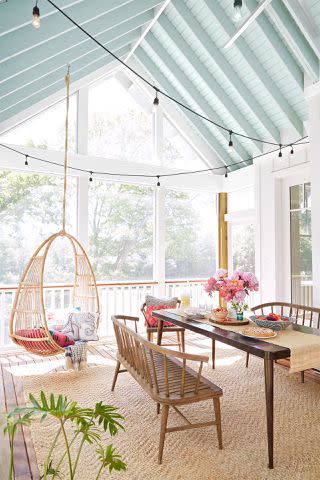
Sunroom
When you add a sunroom like this (a solarium or conservatory), it's a glassed-in living space typically attached to the house and accessible from indoors. It's designed to function as an additional living area during mild weather. However, because sunrooms usually aren't hooked up to your home's heating or cooling system, they may not be comfortable in harsh summers or winters.
Related: How to Install a Hanging Chair for Retro-Style Seating
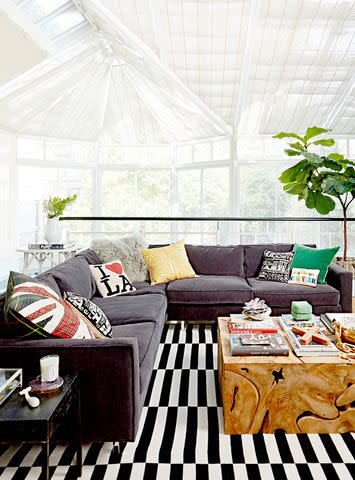
Four-Season Room
Closely related to the sunroom, this option is designed to be heated and cooled. As a result, when you add a sunroom that's four seasons, it can be enjoyed year-round.
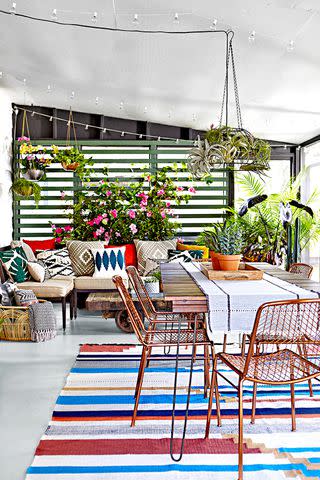
Attached Greenhouse
Featuring the same basic structure and shell construction as a sunroom or four-season room, an attached greenhouse structure offers light, temperature, and humidity levels designed for plants.
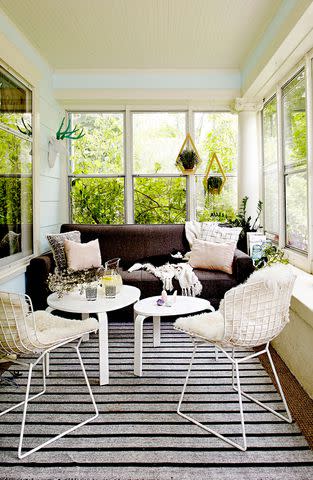
Screened-In Room or Porch
This option has mesh-screen windows or walls rather than glass, which offers the advantage of fresh air without insects. Like the sunroom, it’s habitable only when the weather is agreeable. Because the materials are relatively inexpensive, this is a budget-friendly way to add a sunroom.
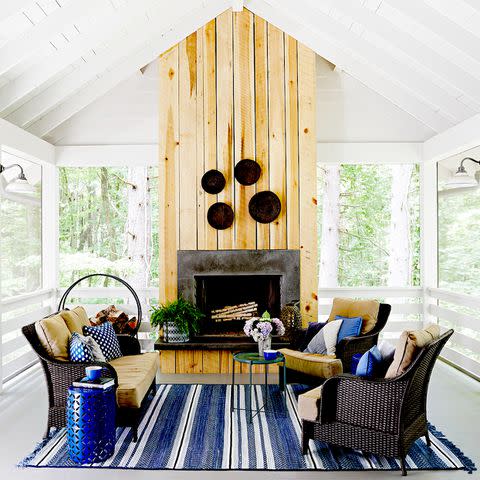
Where to Add a Sunroom
Deciding on the best location to add a sunroom is the first step when planning a glass or screen addition. Consider the typical weather where you live and the direction the sunroom windows will face. In northern climates, an area with southern exposure is best because it will get the most light each day. However, a southern exposure means additional cooling, which could be costly.
An eastern exposure will ease cooling needs by providing sun in the morning and shade the rest of the day, while a western orientation could expose you to harsh afternoon sun that will need to be shaded.
A northern exposure will provide lower levels of light and partial shade most of the day. In the North, this can cause the room to be too cool and damp, but it can work fine in the South, where it may eliminate the need for window treatments or additional cooling.
Related: How to Cool Down a Room Without Air Conditioning
Types of Sunroom Materials
Understanding the components of a seasonal room will help you select the type of space you want.
Vinyl is the most popular material used for the supports of a sunroom. It costs the least, requires minimal upkeep, and offers the best overall strength and insulation. It is available mainly in white. Most vinyl supports are “multiwalled,” meaning they have an internal reinforcement of either aluminum or galvanized steel.
Aluminum doesn’t insulate as well as vinyl, and it’s usually more expensive. However, many rooms that use vinyl-coated vertical supports for aesthetics or added insulation have aluminum as the roof structure for added strength.
Wood is the most expensive choice of structural sunroom material. However, it’s the most appropriate choice for screen rooms because you can easily attach the screen mesh to the timbers. (A screen room needs an extension of the existing roof over the room.) Wood requires periodic maintenance to remain in good shape and look its best.
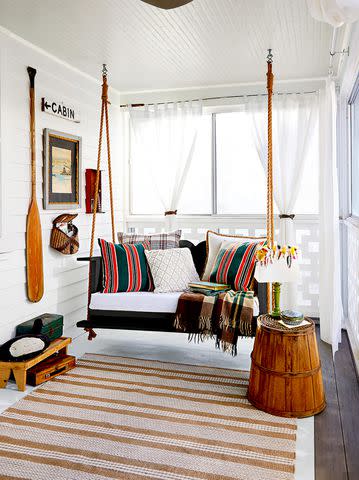
Sunroom Roof and Wall Ideas
Sunrooms, four-season rooms, and greenhouses are walled with glass and roofed with glass or polycarbonate (a tough, transparent thermoplastic). A glass roof is considerably more expensive but provides the most clarity. Look for the U-value of the glass or polycarbonate; this is a measure of how much heat the material conducts. The lower the number, the less heat passes through, so choose the lowest possible U value for the most energy-efficient space.
Glass walls should be silicone double-sealed, A-rated, and labeled “tempered safety” to meet building code requirements. These are the best choices:
Double-glazed glass. This material offers durability, insulation, and glare reduction. A typical U-value ranges from 2 to 2.5. In order of most to least efficient, common glazings are clear, solar bronze and opal.
Double-glazed glass with low-emissivity coating. Applying a “low-E” coating helps the glass reflect heat and ultraviolet rays. The coating reduces the U-value to around 1.7, thus improving energy efficiency.
Double-glazed glass with argon filling and low-E coating. Argon (an inert gas) can be added to further reduce the U-value to about 1.48.
For polycarbonate components, look for these options:
6-millimeter twin-wall polycarbonate. This material is probably the most popular glazing option in conservatory roofs today. This material features a U-value of 2.3.
20-millimeter and 25-millimeter twin-wall polycarbonate. For a stronger roof that also insulates better, these thicknesses are good choices to create a true “room for all seasons.” The typical U-value is 1.6.
Related: The 10 Best Window Insulation Kits of 2023 To Stay Warm All Winter
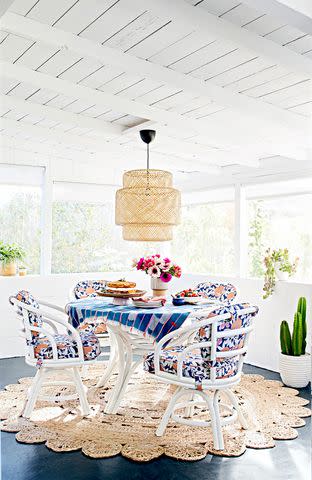
Sunroom Heating and Cooling Ideas
If you can’t build your sunroom in the location that will keep it the most comfortable, or you want more hours to enjoy your all-season room, consider these options:
Add operative skylights to act as heat dumps when the room gets too warm.
Intersperse prefabricated insulating roof panels among the glass roof panels. Look for R-factors of R-16, R-24, or R-32 (the higher the number, the better the insulation quality).
Construct walls so that several windows open. Choose those that will work together to allow optimum airflow.
Install ceiling fans to aid air circulation. Choose models with forward and reverse speeds for summer or winter use.
Install roof shade tracks that hold rigid exterior sunscreens.
Choose window treatments that can be raised and lowered entirely on the hottest or coldest wall areas.
Install a small gas wall heater in the space you’ll use most often during the colder months. For a more luxurious touch, install radiant floor heating.
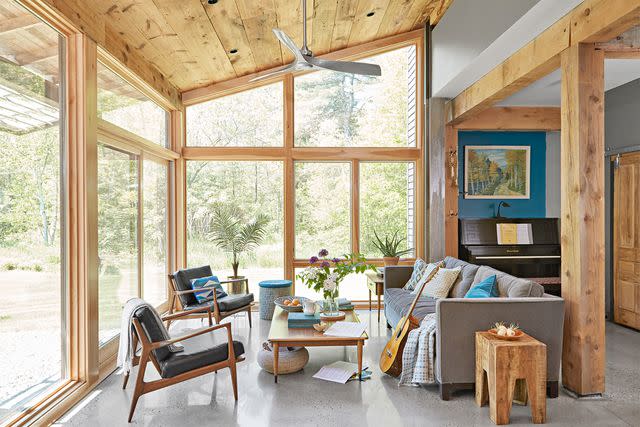
Average Costs to Add a Sunroom
In 2022, experts reported these numbers for the price to add a sunroom:
Standard sunroom construction costs about $120 per square foot. The cost will be about $300 per square foot for a high-end sunroom.
A standard three-season sunroom (a room without insulation) will run between $15,000 and $40,000.
Depending on your customizations, expect to pay between $25,000 and $80,000 for a four-season sunroom with plumbing, insulation, and HVAC.
A pre-fab sunroom that can be built much more quickly than a custom sunroom will cost between $6,000 and $30,000, though they can run higher for more luxurious options.
For more Better Homes & Gardens news, make sure to sign up for our newsletter!
Read the original article on Better Homes & Gardens.

